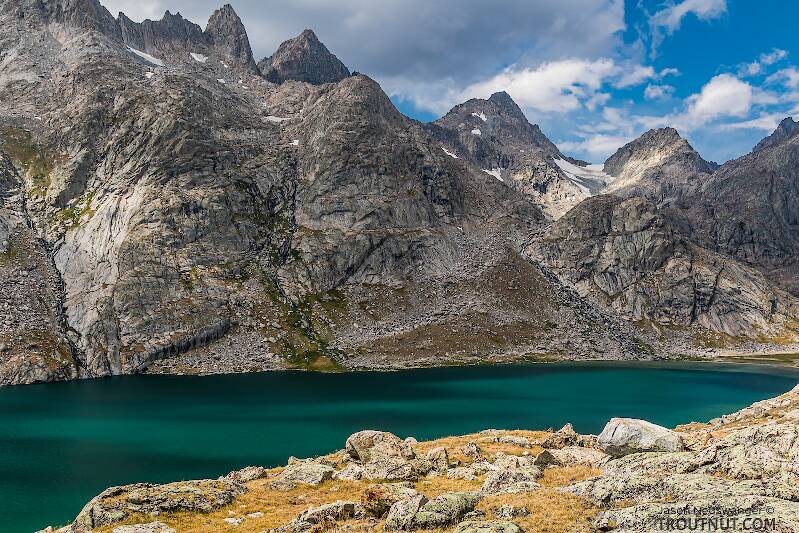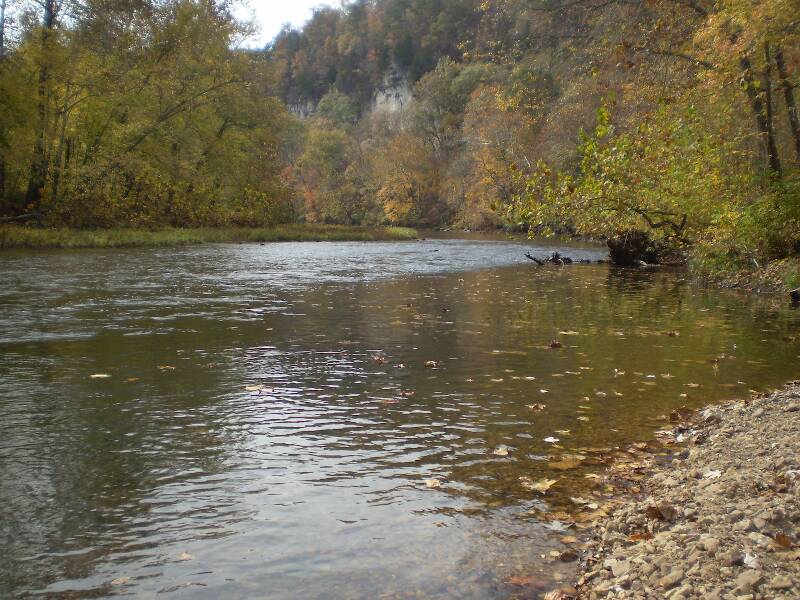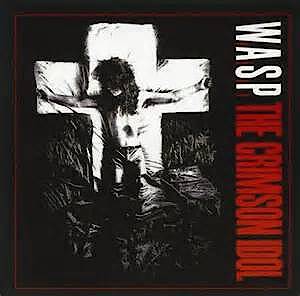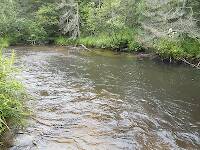
Salmonflies
Pteronarcys californica
The giant Salmonflies of the Western mountains are legendary for their proclivity to elicit consistent dry-fly action and ferocious strikes.
Featured on the forum

This is the first of it's family I've seen, collected from a tiny, fishless stream in the Cascades. The three species of this genus all live in the Northwest and are predators that primarily eat stonefly nymphs Merritt R.W., Cummins, K.W., and Berg, M.B. (2019).

Troutnut is a project started in 2003 by salmonid ecologist Jason "Troutnut" Neuswanger to help anglers and
fly tyers unabashedly embrace the entomological side of the sport. Learn more about Troutnut or
support the project for an enhanced experience here.
Motrout on Oct 22, 2010October 22nd, 2010, 3:11 am EDT
There is a little wild trout stream that I was planning on leaving for this afternoon to fish it for three days, but the USGS gauge says it is just absolutely dead low- I should have known...I can't remember the last time it rained.
I know that will mean tough fishing, but I'm not too worried about that. My question is, does fishing for trout in very low water cause too much stress on the fish? I know not to fish for trout when the water is too warm, but I'm not sure about what the effect is when you're fishing a stream with very low water, but also low water temps. I don't want to be hurting anything, but I'd like not to have to cancel the trip if I can possibly avoid it. What do you think?
I know that will mean tough fishing, but I'm not too worried about that. My question is, does fishing for trout in very low water cause too much stress on the fish? I know not to fish for trout when the water is too warm, but I'm not sure about what the effect is when you're fishing a stream with very low water, but also low water temps. I don't want to be hurting anything, but I'd like not to have to cancel the trip if I can possibly avoid it. What do you think?
"I don't know what fly fishing teaches us, but I think it's something we need to know."-John Gierach
http://fishingintheozarks.blogspot.com/
http://fishingintheozarks.blogspot.com/
RleeP on Oct 22, 2010October 22nd, 2010, 3:54 am EDT
Its a judgment call..
Trout in very low water are more exposed to the general run of predation (heron, mink, snakes, whatever) and as such, "may" sometimes be forced to expend more energy than they would otherwise, a potential source of "stress", I suppose.
By and large though, if it is a healthy stream with reliably cold flows and some gradient, dissolved oxygen and the stress that the lack of same can cause in trout isn't going to be a factor. If I remember my HS physics correctly, water's ability to provide DO is somewhat temperature dependent and cold water has more DO.
All in all, I don't think it would be a bad thing to fish this stream under low flow conditions. If its like most streams I've fished when they are very low, you'll be in more danger of trauma from stress than the fish..:)
Trout in very low water are more exposed to the general run of predation (heron, mink, snakes, whatever) and as such, "may" sometimes be forced to expend more energy than they would otherwise, a potential source of "stress", I suppose.
By and large though, if it is a healthy stream with reliably cold flows and some gradient, dissolved oxygen and the stress that the lack of same can cause in trout isn't going to be a factor. If I remember my HS physics correctly, water's ability to provide DO is somewhat temperature dependent and cold water has more DO.
All in all, I don't think it would be a bad thing to fish this stream under low flow conditions. If its like most streams I've fished when they are very low, you'll be in more danger of trauma from stress than the fish..:)
Motrout on Oct 22, 2010October 22nd, 2010, 4:54 am EDT
The water should be plenty cold-and it does have some riffles to oxygenate the water. I guess I'll give it a shot.
"I don't know what fly fishing teaches us, but I think it's something we need to know."-John Gierach
http://fishingintheozarks.blogspot.com/
http://fishingintheozarks.blogspot.com/
SlateDrake9 on Oct 22, 2010October 22nd, 2010, 4:58 am EDT
Water temp is the factor I'd worry about for the fish.
But, you have to ask yourself, how much fun will the stream be to fish if it is that low? Is it deep enough for the fish to fight back? Enough water/current to get a drift? Enough water to fish in anything but the deepest holes, which probably aren't all that deep if it's that low?
But, you have to ask yourself, how much fun will the stream be to fish if it is that low? Is it deep enough for the fish to fight back? Enough water/current to get a drift? Enough water to fish in anything but the deepest holes, which probably aren't all that deep if it's that low?
Fishing with bait is like swearing in church.
-- Slate Drake
-- Slate Drake
Oldredbarn on Oct 22, 2010October 22nd, 2010, 7:38 am EDT
I agree with Paul...This time of year when the waters down the fish are in all those places where you would think they might be...You will be able to see the deeper runs etc and floating a fly over that is exciting...
You will stick out like a sore thumb to these fish so it won't be like taking candy from a baby, so think "far & fine".
Don't over play the fish and take something to measure the water temp...I think it's called a thermometer.
Spence
Maybe as a side note...If you see a brookie's spawning bed, you may want to move on and let them get about the work at hand.
You will stick out like a sore thumb to these fish so it won't be like taking candy from a baby, so think "far & fine".
Don't over play the fish and take something to measure the water temp...I think it's called a thermometer.
Spence
Maybe as a side note...If you see a brookie's spawning bed, you may want to move on and let them get about the work at hand.
"Even when my best efforts fail it's a satisfying challenge, and that, after all, is the essence of fly fishing." -Chauncy Lively
"Envy not the man who lives beside the river, but the man the river flows through." Joseph T Heywood
"Envy not the man who lives beside the river, but the man the river flows through." Joseph T Heywood
Ericd on Oct 22, 2010October 22nd, 2010, 10:27 am EDT
What I like about "visiting" and/or fishing a stream in low water is being able to see the underwater structure much better so I can better fish it when the water is up to whatever normal is. I know all of that changes from season to season and flood to flood, but a lot of it doesn't seem to change that much. I say go for no other reason than research.
Adirman on Oct 23, 2010October 23rd, 2010, 12:48 am EDT
I'm with what What ericd said!! Whe the water's low, you can go simply to observe structure(and fish, of course!)so that in higher water, you get a better idea where the big holes are, large obstructions like rocks, etc., that is, if you can remember!
Bobbyg on Oct 23, 2010October 23rd, 2010, 10:47 am EDT
Just me, and you guys can do whatever you feel is best, but I just don't fish for small stream fish when the water is almost depleted.
I agree that it is a good time to just observe the stream.
I agree that it is a good time to just observe the stream.
"Many men go fishing all of their lives without knowing it is not fish they are after."
- Henry David Thoreau
- Henry David Thoreau
Motrout on Oct 24, 2010October 24th, 2010, 9:13 am EDT
I did go, and I was really surprised when I got there- I think there may have been a problem with the USGS gauge or something, because the water was really just a little below normal and 55 degrees. Nothing even remotely concerning.
In any case, the fishing was great. The trout were up in the riffles and slamming attractor dries all day long. Fun stuff.
In any case, the fishing was great. The trout were up in the riffles and slamming attractor dries all day long. Fun stuff.
"I don't know what fly fishing teaches us, but I think it's something we need to know."-John Gierach
http://fishingintheozarks.blogspot.com/
http://fishingintheozarks.blogspot.com/
Quick Reply
Related Discussions
Topic
Replies
Last Reply
4
Oct 12, 2011
by Oldredbarn
by Oldredbarn
0
Apr 29, 2015
by Wbranch
by Wbranch






